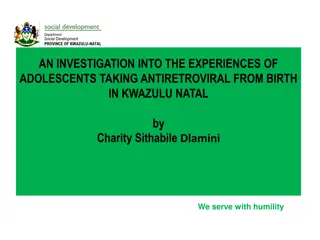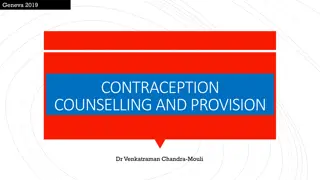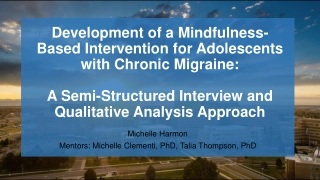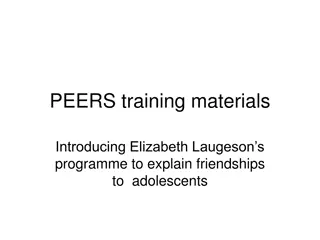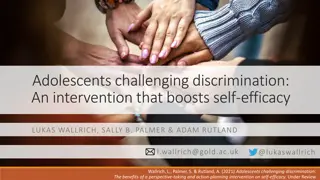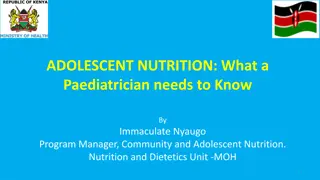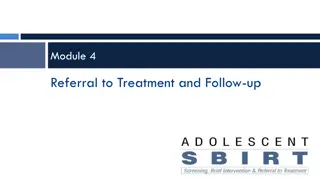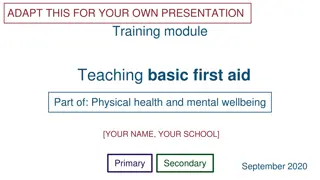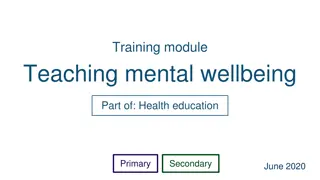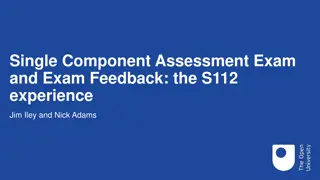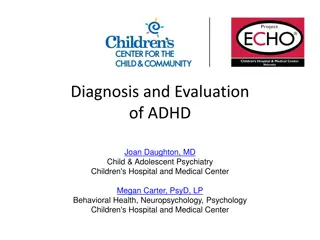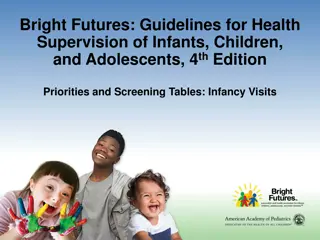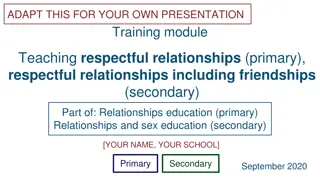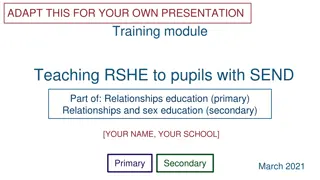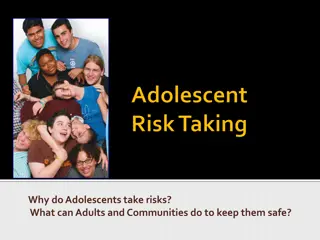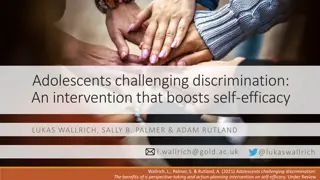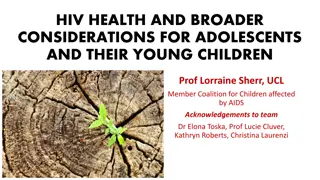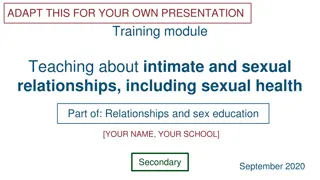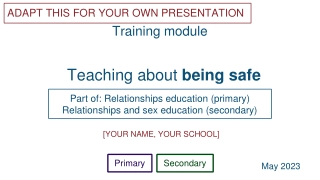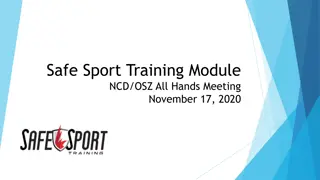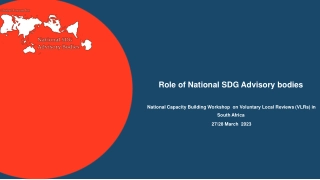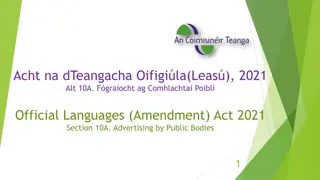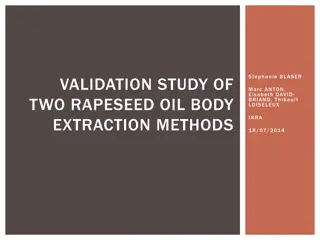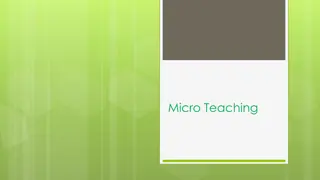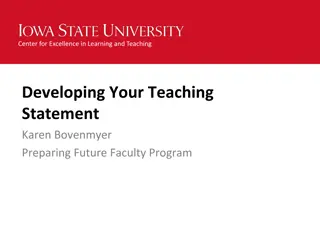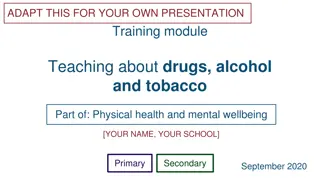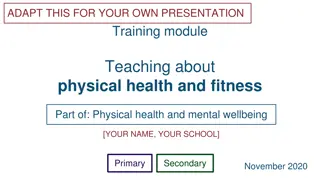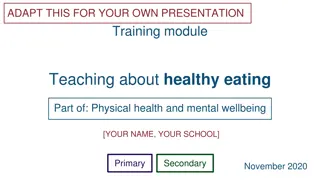Teaching Adolescents about Changing Bodies: A Comprehensive Training Module
This training module focuses on teaching educators how to address the changing adolescent body in the context of physical health and mental wellbeing. It covers the new curriculum guidelines, strategies for effective teaching, safeguarding practices, and examples of best practices. Emphasizing the importance of preparing students for puberty, the module integrates closely related topics such as health education, physical fitness, healthy eating, and mental wellbeing. By the end of the training, participants will be equipped with the necessary knowledge and confidence to engage with students on this critical subject.
Download Presentation

Please find below an Image/Link to download the presentation.
The content on the website is provided AS IS for your information and personal use only. It may not be sold, licensed, or shared on other websites without obtaining consent from the author. Download presentation by click this link. If you encounter any issues during the download, it is possible that the publisher has removed the file from their server.
E N D
Presentation Transcript
ADAPT THIS FOR YOUR OWN PRESENTATION Training module Teaching about the changing adolescent body Part of: Physical health and mental wellbeing [YOUR NAME, YOUR SCHOOL] Primary Secondary September 2020
Contents 3 About this training module 5 Teaching the new curriculum 14 Safeguarding 16 Ground rules 19 Primary curriculum 37 Secondary curriculum 46 Examples of good practice 52 Activities and templates for trainers 2
About this training module This non-statutory training module supplements the statutory guidance on teaching about the changing adolescent body, which schools should read in full. Schools can choose whether and how to follow or adapt this training module and should refer to the Early Career Framework for pedagogical guidance. Subject leads using this presentation in training should also refer to the Activities and templates for trainers section at the end. It is not suggested that all slides in this module are used in a single training session. 3
What you get out of today By the end of this training you should: know the statutory guidance know some of the ways you can teach the required knowledge have strategies to deal with questions that come up in class feel more confident teaching about the changing adolescent body 4
Preparing pupils for puberty From September 2020 schools must have regard to the new statutory guidance for teaching about the changing adolescent body as part of health education. The guidance explains how this teaching will benefit pupils. STATUTORY GUIDANCE Puberty including menstruation should be covered in Health Education and should, as far as possible, be addressed before onset. This should ensure male and female pupils are prepared for changes they and their peers will experience. (p31) 6
Closely related topics Changing adolescent body is closely related to the science curriculum as well as topics such as: Health and prevention Physical health and fitness Healthy eating Mental wellbeing Intimate and sexual relationships, including sexual health (secondary) Therefore you should: consider thematic links across key topics and the whole school when planning and delivering lessons find ways to link knowledge and vocabulary across topics 7
Primary and secondary teaching Some slides in this training have a Primary or Secondary label to indicate that the material is usually first introduced in that phase. Where content is relevant to both stages of education (e.g. menstruation), this is made clear in the text. STATUTORY GUIDANCE Schools have flexibility to design and plan age-appropriate subject content. (p31) Using your knowledge of your pupils and school community you should determine what it is helpful for pupils to know at each age. 8
LGBT needs and inclusion Primary schools are enabled and encouraged to cover LGBT (lesbian, gay, bisexual and transgender) content if they consider it age appropriate to do so. Secondary schools should include LGBT content. When doing so, schools should ensure: LGBT-relevant knowledge and examples are included throughout programmes of study (not one-off teaching) inclusive language is used, considering how individual pupils may relate to particular topics 9
Teaching in mixed groups Avoid segregating by gender unless there is a clear rationale for doing so in order to meet the needs of pupils (e.g. giving girls a chance to ask questions about menstruation in a female-only environment). Ensure pupils have opportunities to ask teachers questions in small groups or individually if they have personal concerns about topics. STATUTORY GUIDANCE Schools should consider what they can do to foster healthy and respectful peer- to-peer communication and behaviour between boys and girls, and provide an environment, which challenges perceived limits on pupils based on their gender or any other characteristic, including through these subjects and as part of a whole-school approach. (p14) 10
Faith backgrounds All schools must: ensure faith/religious background of pupils are taken into account when planning teaching, so that topics are appropriately handled comply with the Equality Act 2010, under which religion and belief are among the protected characteristics STATUTORY GUIDANCE In all schools, when teaching these subjects, the religious background of all pupils must be taken into account when planning teaching, so that the topics that are included in the core content in this guidance [the statutory guidance] are appropriately handled. (p12) 11
Pupils with SEND You will need to plan lessons to allow all pupils to access and practise the core knowledge, using your expertise as you normally would. You might want to link lesson outcomes with statutory preparing for adulthood outcomes for those with an education, health and care (EHC) plan. (See SEND code of practice, section 8.) STATUTORY GUIDANCE In special schools and for some SEND pupils in mainstream schools there may be a need to tailor content and teaching to meet the specific needs of pupils at different developmental stages. As with all teaching for these subjects, schools should ensure that their teaching is sensitive, age-appropriate, developmentally appropriate and delivered with reference to the law. (p15) 12
Teacher wellbeing and engagement Relationships education and health education cover a wide range of topics, some of which individual teachers might find personally challenging in different ways. It is important to feel you can ask for support or raise questions if: you have personal experience of a topic which makes teaching that content particularly challenging for you you have personal views on a topic that mean you need to discuss how you can ensure the teaching is delivered objectively Talk to you line manager, in the first instance, if you do need support. 13
Safeguarding 14
Safeguarding (1) Pupils may be affected by issues discussed in lessons. Let your designated safeguarding lead or deputy and any other relevant staff, such as pastoral leads, know what you are teaching. This will enable them to identify and speak to relevant pupils, especially those who they know may have been directly impacted by issues covered in the lessons and those with adverse childhood experiences. Teachers may need to deal with disclosures/concerns (e.g. of abuse or offending behaviour) in a way that safeguards pupils in line with school policies, especially the child protection policy. 15
Ground rules 16
Create class ground rules Clear class ground rules can help when teaching about sensitive topics. They also support confidentiality and safeguarding of pupils. Good practice is for ground rules to be: discussed and understood by all clear and practical modelled by the teacher followed consistently and enforced updated when needed visible in lessons (for example, posters) 17
Example ground rules Respect privacy. We can discuss examples but do not use names or descriptions that identify anyone, including ourselves. Listen to others. It is okay to disagree with each other, but we should listen properly before making assumptions or deciding how to respond. When disagreeing, challenge the statement not the person. No judgement. We can explore beliefs and misunderstandings about a topic without fear of being judged. Choose level of participation. Everyone has the right to choose not to answer a question or join discussion. We never put anyone on the spot (no personal questions or pressure to answer). 18
Introducing puberty STATUTORY GUIDANCE Know key facts about puberty and the changing adolescent body, particularly from age 9 through to age 11, including physical and emotional changes. Teach that puberty is part of the human life cycle. It is the process of growing into an adult and becoming able to reproduce. Explain that puberty usually starts between the ages of 8 and 14 and lasts for up to 4 years. Children will start puberty at different times. Girls usually start earlier than boys. It is important to introduce all pupils to the idea of puberty before they are likely to start. Teacher s reference: Stages of puberty (NHS.UK). Primary 20
Hormones that affect both sexes STATUTORY GUIDANCE Know key facts about puberty and the changing adolescent body, particularly from age 9 through to age 11, including physical and emotional changes. Teach that hormones control the changes young people go through during puberty. Explain that some hormones ( adrenal androgens ) cause the same changes to boys and girls bodies. These changes include: growth of pubic and underarm hair changes to sweat, making body odour more likely the skin to produce extra oil (sebum), which can cause spots or acne Primary 21
Hormones that affect boys or girls STATUTORY GUIDANCE Know key facts about puberty and the changing adolescent body, particularly from age 9 through to age 11, including physical and emotional changes. In girls, some puberty hormones travel to the ovaries (oval-shaped organs either side of the uterus) and encourage them to: grow and release eggs release oestrogen , which causes changes to the girl s body and prepares her for pregnancy In boys, some puberty hormones travel to the testes and encourage them to: start producing sperm release testosterone , which causes changes to the boy s body Primary 22
STATUTORY GUIDANCE Know key facts about puberty and the changing adolescent body, particularly from age 9 through to age 11, including physical and emotional changes. Changes to a girl s body in puberty Teach that girls will usually experience: breast growth growth of their genitalia white vaginal discharge a growth spurt a gradual deepening of their voice weight gain as their body changes shape their hips getting wider and their waist narrower menstruation (they will start their period) Primary 23
The menstrual cycle STATUTORY GUIDANCE Know about menstrual wellbeing including the key facts about the menstrual cycle. Explain to pupils of both sexes that the menstrual cycle is the process through which the body: thickens the lining of the uterus for pregnancy releases an egg (which is needed for pregnancy) If there is no pregnancy, the body releases the lining through the vagina/cervix. This is called menstruation (or a period ). The average menstrual cycle is 25 to 32 days. An average period lasts 3 to 8 days (usually about 5 days). Primary 24
Menstruation (1) STATUTORY GUIDANCE Know about menstrual wellbeing including the key facts about the menstrual cycle. Teach that menstrual blood looks different to blood from a cut. Its colour can vary (red, pink, brown or black) and it may contain lumps. Explain that menstruation may: last a different number of days have different lengths between them feel and look different over time as one gets older Teach that after a few months periods should become regular every month (but regular varies from person to person). Primary 25
Menstruation (2) STATUTORY GUIDANCE Know about menstrual wellbeing including the key facts about the menstrual cycle. Explain that girls may experience spotting (light bleeding from the vagina). This can be a sign menstruation is about to start. Girls may also get tender breasts before menstruation. At any point in the menstrual cycle, they may also experience: mood swings or feeling emotional stomach cramps or bloating increased appetite spots vaginal discharge Primary 26
Menstrual products (1) STATUTORY GUIDANCE Know about menstrual wellbeing including the key facts about the menstrual cycle. Teach that menstrual products are designed to absorb or collect menstrual blood. Explain that menstrual flow may vary, and most girls/women will need to change their menstrual products every 3 to 4 hours. Explain that there are different products available for different volumes of flow, and that it is important to follow instructions on products. Primary 27
Menstrual products (2) STATUTORY GUIDANCE Know about menstrual wellbeing including the key facts about the menstrual cycle. Introduce different kinds of menstrual products, including: pads which you stick on your underwear - only need to be changed as often as instructions recommend tampons (applicator/non-applicator) - used internally menstrual cups - used internally and can be reused washable period underwear - reusable All schools in England can now access free menstrual products. You can read about the Periods Product Scheme on GOV.UK. Primary 28
Menstrual wellbeing Explain that period pain is common. Light exercise can help, and girls should be able to carry on with day-to- day activities. STATUTORY GUIDANCE Know about menstrual wellbeing including the key facts about the menstrual cycle. Ensure that girls know they can speak to a parent, school nurse, teacher or GP if they: have pain that interferes with regular activities are worried their period is too heavy are having periods that last longer than 7 days have questions about menstruation (e.g. questions about the look of their menstrual blood) Primary You can read more about starting periods on NHS.UK. 29
STATUTORY GUIDANCE Know key facts about puberty and the changing adolescent body, particularly from age 9 through to age 11, including physical and emotional changes. Changes to a boy s body in puberty Teach that boys will usually experience: enlargement of their larynx (Adam s apple) their voice breaking muscle growth genitalia become bigger (testicle growth followed by penis growth) a growth spurt Primary 30
Understanding the penis STATUTORY GUIDANCE Know key facts about puberty and the changing adolescent body, particularly from age 9 through to age 11, including physical and emotional changes. Teach that everyone s genitalia are different (e.g. penises and testicles are different sizes). It is normal for testicles to hang at different heights, but they should hang outside of the body. Boys should speak to a doctor if their testicles are permanently inside their body, as this may require treatment. Some people are also circumcised (foreskin removed). Explain that males: have testicles which produce sperm from puberty can produce sperm throughout their life Primary 31
Erections STATUTORY GUIDANCE Know key facts about puberty and the changing adolescent body, particularly from age 9 through to age 11, including physical and emotional changes. Teach that an erection happens when vessels in the penis fill with blood. Erections are natural and can happen: when someone is sexually aroused when the bladder is full (sometimes) when someone is sleeping (potentially several times a night) at other times, and sometimes without us knowing why Primary 32
Ejaculation STATUTORY GUIDANCE Know key facts about puberty and the changing adolescent body, particularly from age 9 through to age 11, including physical and emotional changes. Teach that ejaculation happens when the penis is stimulated and when someone has an orgasm and sperm is released from the head of the penis. This can take different lengths of time. The amount and strength of the ejaculation varies. Explain about wet dreams , where boys/men may have erections during their sleep and wake up having ejaculated. Teach that people should not be embarrassed about having wet dreams. Primary 33
Emotions and behaviour STATUTORY GUIDANCE Know key facts about puberty and the changing adolescent body, particularly from age 9 through to age 11, including physical and emotional changes. Explain that, during puberty, emotions can feel exaggerated or out of control - and this can impact on behaviour (e.g. making arguments more likely). Teach that emotional changes can be due to fluctuating sex hormones and increased levels of cortisol (the stress hormone ). Teach ways to manage challenging emotions, such as: getting regular exercise getting enough sleep (at least 9 hours) talking to someone trusted waiting for a mood to settle before responding or making an important decision Primary 34
Healthy eating during puberty STATUTORY GUIDANCE Know key facts about puberty and the changing adolescent body, particularly from age 9 through to age 11, including physical and emotional changes. Explain that changes to the body can also affect what we feel like eating. This is linked to brain development, but it can also be linked to where a person is in their menstrual cycle. Teach pupils that it is important that we all have a healthy diet that is rich in iron, calcium and vitamin D to support our bodies. Primary 35
Changes in sleep cycles STATUTORY GUIDANCE Know key facts about puberty and the changing adolescent body, particularly from age 9 through to age 11, including physical and emotional changes. Sleep is triggered by the hormone melatonin. During puberty, melatonin is released up to 2 hours later than it was before. This can affect sleep cycles (e.g. making it harder to get up in the morning). Encourage pupils to develop a health sleep routine, for example by: switching off digital devices 2 hours before sleep switching off phones when in bed going to bed early to get at least 9 hours sleep having a regular routine for going to bed and getting up in the morning Primary 36
Secondary curriculum STATUTORY GUIDANCE Schools should continue to develop knowledge on topics specified for primary as required and in addition cover the following content by the end of secondary. (p36) 37
The brain during puberty STATUTORY GUIDANCE Know the main changes which take place in males and females, and the implications for emotional and physical health. Teach that during puberty the brain is still maturing. When making decisions young people often rely on the amygdala , the part of the brain linked to emotions, aggression and impulses. So they are more likely to: take more risks than other people have stronger emotions or be angrier find it hard to express themselves deal with social issues Of course, young people can still be warm, sociable and make good decisions. But sometimes they may need help with decision-making or managing their emotions. Secondary 38
Managing emotions and behaviour STATUTORY GUIDANCE Know the main changes which take place in males and females, and the implications for emotional and physical health. Explain how behaviour and decisions during puberty can impact on wellbeing and chances in life. Explore ways pupils can manage their emotions and mitigate risk, e.g. by: reducing impulsive decision-making exploring their feelings with someone they trust Teachers may also refer to primary curriculum content on: changes to the body during puberty emotions and behaviour Secondary 39
Managing sexual attraction STATUTORY GUIDANCE Know the main changes which take place in males and females, and the implications for emotional and physical health. Explain that during puberty testosterone and oestrogen make people more interested in sex - but this doesn t mean that we are necessarily emotionally ready for it. Remind pupils that the legal age of consent is 16. Teach the risks of engaging in sexual relationships before we are ready (e.g. STIs and pregnancy). Explore ways in which young people can enjoy healthy, relationships with others while: managing feelings of sexual attraction avoiding risky decisions about sex Secondary 40
Diversity of developing bodies STATUTORY GUIDANCE Know the main changes which take place in males and females, and the implications for emotional and physical health. Building on primary curriculum content about changes to the adolescent body, explain that some people are born with sex organs/genitalia that are not exclusively male or female. For example, someone can have female external genitalia, abdominal testes but no uterus. Teach that these differences in sex development (DSD) are rare. Advise pupils that if they think they have DSD they can speak to their GP, who can refer them to a specialist health professional. Secondary 41
Hygiene during puberty STATUTORY GUIDANCE Know the main changes which take place in males and females, and the implications for emotional and physical health. Teaching about puberty provides an opportunity to tell pupils about good hygiene practices. Explain that as our bodies go through puberty more regular washing and showering might be needed due to increased sweating and body odour. Remind pupils that deodorant is best used alongside regular washing. Secondary 42
Penis hygiene STATUTORY GUIDANCE Know the main changes which take place in males and females, and the implications for emotional and physical health. Teach pupils that it is important to practice good genital hygiene in relation to the penis. Explain that: the penis needs to be kept clean the testicles and the pubic area should also be washed the foreskin should be pulled back to enable washing and removal of smegma (thick, white substance that collects under the foreskin) Secondary 43
Vulva hygiene STATUTORY GUIDANCE Know the main changes which take place in males and females, and the implications for emotional and physical health. Explain that after going to the toilet, girls should wipe from front to back to keep bacteria away from the vulva. This helps prevent cystitis. Explain that the vagina produces clear mucus to help keep it clean, and whitish cervical discharge linked to ovulation (part of menstrual cycle). Just like inside the mouth, it is supposed to be a bit wet all of the time. Washing normally and regularly changing period products is enough. Avoid products to keep the vagina clean . They disrupt the natural balance and can lead to smelly discharge and irritation. Secondary 44
Menstrual wellbeing STATUTORY GUIDANCE Know the key facts about puberty, the changing adolescent body and menstrual wellbeing. Menstrual conditions, such as endometriosis, can have a significant impact, both physically and mentally. It is important that pupils understand what is normal during menstruation, so they can recognise problems and seek help. Teachers may like to revisit content about menstruation from the primary curriculum part of this presentation, so that they are able to advise pupils on when they should seek help - and who to speak to. You can read more on menstrual conditions at: Period problems - NHS (www.nhs.uk). Secondary 45
Good practice (1) The following are just some of the approaches you might consider when preparing to teach about the changing adolescent body. You will need to adapt these approaches to ensure they are age appropriate and developmentally appropriate for your pupils. Good practice 47
Good practice (2) Ensure the content is taught at the right time so that pupils are not lacking the knowledge they need to understand their personal development, as well as that of peers and others. Ensure LGBT-relevant knowledge and examples are included throughout teaching (not a one-off session) and use inclusive language, considering how individual pupils may relate to particular topics. In this module girls refers to those whose natal sex is female. Similarly, boys refers to those whose natal sex is male. However, teachers should be aware of the individual needs of all pupils and use inclusive language where possible. Good practice 48
Good practice (3) Avoid segregating by gender unless there is a clear rationale for doing so in order to meet the needs of pupils. Ensure pupils have opportunities to ask teachers questions in small groups or even individually if they have concerns about topics that relate directly to them - e.g. menstruation. Use medically correct language to accurately describe human anatomy, including genitalia (e.g. vulva, vagina, penis, testicles, foreskin). Address stigma and embarrassment associated with puberty by taking opportunities to talk about different aspects of puberty often and in different contexts within school. Good practice 49
Good practice (4) Give pupils opportunities to handle relevant objects (e.g. period products, deodorant) and to ask questions about them. Avoid using brand names and be aware that some cultures may not agree with certain menstrual products. You may want to avoid referring to menstrual products as sanitary or hygiene products as it could give the impression that periods are dirty. Good practice 50


